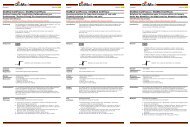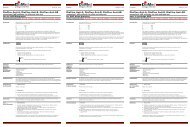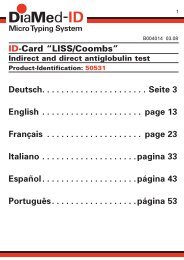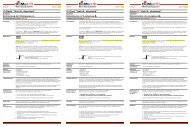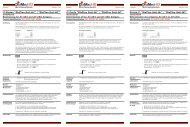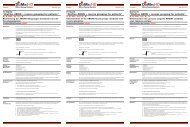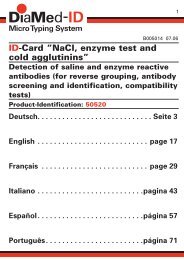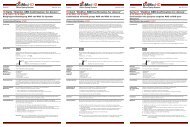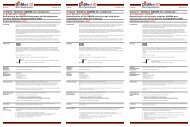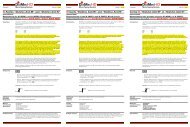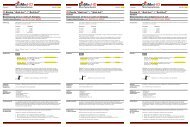ID-Karte “ABO/D + reverse grouping“
ID-Karte “ABO/D + reverse grouping“
ID-Karte “ABO/D + reverse grouping“
You also want an ePaper? Increase the reach of your titles
YUMPU automatically turns print PDFs into web optimized ePapers that Google loves.
Deutsch B001129 03.08 English B001129 03.08 Français B001129 03.08<br />
<strong>ID</strong>-<strong>Karte</strong> <strong>“ABO</strong>/D + <strong>reverse</strong> <strong>grouping“</strong><br />
A, B, D, ctl/A 1 , B<br />
human<br />
Blutgruppenbestimmung ABO und RhD kombiniert mit<br />
Serumgegenprobe<br />
Produkt-Identifikation: 50081<br />
<strong>ID</strong>-Card <strong>“ABO</strong>/D + <strong>reverse</strong> <strong>grouping“</strong><br />
A, B, D, ctl/A 1 , B<br />
human<br />
Blood groups ABO and RhD combined with <strong>reverse</strong><br />
grouping<br />
Product-Identification: 50081<br />
Carte-<strong>ID</strong> <strong>“ABO</strong>/D + <strong>reverse</strong> <strong>grouping“</strong><br />
A, B, D, ctl/A 1 , B<br />
humain<br />
Groupages ABO et RhD combinés avec épreuve sérique<br />
Identification de produit: 50081<br />
Einleitung<br />
Die Bestimmung der ABO-Blutgruppen mit Anti-A -und Anti-B-Testseren ist bekannt als direkter<br />
Blutgruppentest.<br />
Introduction<br />
ABO blood group typing, using anti-A and anti-B test sera, is known as the direct or forward grouping<br />
test.<br />
Introduction<br />
Le groupage ABO, utilisant les sérums-tests anti-A et anti-B est connu en tant que groupage direct.<br />
Für die Serumgegenprobe verwendet man Erythrozyten mit bekannter ABO-Antigen-Spezifität, um das<br />
Vorhandensein bzw. die Abwesenheit der Anti-A und Anti-B Isoagglutinine zu erkennen. Unterschiede<br />
zwischen der Antigenbestimmung und der Serumgegenprobe erfordern weitere Untersuchungen [1].<br />
Reverse grouping uses red cell reagents of known ABO antigen specificity to indicate the presence<br />
or absence of anti-A and anti-B isoagglutinins, the results of which determine the <strong>reverse</strong> group.<br />
Discrepancies between forward and <strong>reverse</strong> grouping require further investigation [1].<br />
L’épreuve sérique, utilisant des hématies-tests de spécificité antigénique ABO connue, détermine la<br />
présence ou l’absence d’isoagglutinines anti-A ou anti-B. Toute discordance entre épreuve érythrocytaire<br />
et épreuve sérique nécessite des investigations supplémentaires [1].<br />
Die Aussage über die Blutgruppe basiert auf den Resultaten der Blutgruppenbestimmung und der<br />
Serumgegenprobe.<br />
Classification of blood groups must be based on both forward and <strong>reverse</strong> grouping.<br />
La détermination des groupes sanguins doit être basée sur les résultats du groupage direct et de<br />
l’épreuve sérique.<br />
Die <strong>ID</strong>-<strong>Karte</strong> <strong>“ABO</strong>/D + <strong>reverse</strong> grouping” ermöglicht die Blutgruppenbestimmung und die<br />
Serumgegenprobe sowie die RhD Bestimmung.<br />
The <strong>ID</strong>-Card <strong>“ABO</strong>/D + <strong>reverse</strong> grouping” allows combined testing of forward and <strong>reverse</strong> grouping as<br />
well as RhD determination.<br />
La carte-<strong>ID</strong> <strong>“ABO</strong>/D + <strong>reverse</strong> grouping” permet d’effectuer un test combiné avec groupage direct et<br />
épreuve sérique, ainsi que la détermination du RhD.<br />
Reagenzien<br />
Reagents<br />
Réactifs<br />
<strong>ID</strong>-<strong>Karte</strong> <strong>“ABO</strong>/D + <strong>reverse</strong> grouping” enthält ein Gemisch aus polyklonalem und monoklonalem Anti-A<br />
(Zellinie: A5) sowie polyklonalem Anti-B und Anti-D humanen Ursprungs, in der Gelmatrix. Das<br />
Mikroröhrchen ctl dient zur negativen Kontrolle. Zwei Mikroröhrchen mit “neutralem” Gel dienen zur<br />
Serumgegenprobe mit A 1 und B Zellen. Konservierungsmittel: < 0,1% NaN 3 .<br />
<strong>ID</strong>-Card <strong>“ABO</strong>/D + <strong>reverse</strong> grouping” contains a mixture of polyclonal and monoclonal anti-A (cell line:<br />
A5), polyclonal anti-B and anti-D antibodies of human origin, within the gel matrix. The microtube ctl is<br />
the negative control. Two microtubes with “neutral” gel serve for <strong>reverse</strong> grouping with A 1 and B cells.<br />
Preservative: < 0,1% NaN 3 .<br />
Carte-<strong>ID</strong> <strong>“ABO</strong>/D + <strong>reverse</strong> grouping” contenant un mélange des anticorps polyclonaux et monoclonaux<br />
anti-A (lignée céllulaire: A5), polyclonaux anti-B et anti-D d’origine humaine, inclus dans le gel. Le<br />
microtube ctl est le contrôle négatif. Deux microtubes avec du gel “neutre” servent à l’épreuve sérique<br />
avec les hématies A 1 et B. Conservateur: < 0,1% NaN 3 .<br />
Achtung: Die Ausgangsmaterialien, aus denen diese Produkte hergestellt wurden, haben sich bei der<br />
Prüfung mit zugelassenen Reagenzien als nicht reaktiv für HBsAg, HCV und HIV (1 und 2) erwiesen.<br />
Allerdings kann kein verfügbares Testverfahren das Nichtvorhandensein infektiöser Substanzen<br />
garantieren. Aus Humanblut gewonnene Produkte sollten immer als potentiell infektiös angesehen<br />
werden.<br />
Caution: The source materials from which these products were manufactured, were found non reactive<br />
for HBsAg, HCV and HIV (1+2) when tested with licensed reagents. However, no known test method can<br />
assure that infectious agents are absent. Products from human blood should be considered potentially<br />
infectious.<br />
Attention: Les matières utilisées pour la fabrication de ces produits n’ont montré aucune réaction<br />
lors des dépistages de l’AgHBs, HIV1, HIV2 et HCV avec des réactifs agréés. Cependant aucune des<br />
méthodes connues ne peut assurer l’absence d’agents infectieux. Les produits ayant pour origine du<br />
sang humain doivent être considérés comme des produits potentiellement infectieux.<br />
Nicht in der Nähe von Hitzequellen, Klimaanlagen oder Lüftungsausgängen lagern.<br />
Stabilität: siehe Verfallsdatum auf dem Etikett.<br />
Do not store near any heat, air conditioning sources or ventilation outlets.<br />
Stability: see expiry date on label.<br />
Ne pas stocker à proximité d’une source de chaleur, d’une climatisation ou d’une sortie<br />
de ventilation.<br />
Stabilité: voir date de péremption sur l’étiquette.<br />
Zusätzlich<br />
benötigte<br />
Reagenzien<br />
• <strong>ID</strong>-Diluent 1: Modifizierte Bromelin-Lösung zur Herstellung der Erythrozytensuspensionen.<br />
• Testerythrozyten: <strong>ID</strong>-DiaCell A 1 + B in einer 0,8%igen Suspension, in 10 mL Fläschchen, gebrauchsfertig.<br />
(siehe diesbezügliche Packungsbeilage)<br />
Additional<br />
reagent<br />
required<br />
• <strong>ID</strong>-Diluent 1: modified Bromelin solution for red cell suspension.<br />
• Test cell Reagents: <strong>ID</strong>-DiaCell A 1 and B in a 0,8% suspension, in 10 mL vials, ready-to-use.<br />
(see related package insert)<br />
Réactifs<br />
supplémentaires<br />
nécessaires<br />
• <strong>ID</strong>-Diluent 1: solution de broméline modifié pour suspensions d’hématies.<br />
• Hématies-tests: <strong>ID</strong>-DiaCell A 1 et B en suspension de 0,8%, en flacons de 10 mL prêts à l’emploi.<br />
(voir mode d’emploi correspondant)<br />
Weitere<br />
erforderliche<br />
Materialien<br />
• <strong>ID</strong>-Dispenser<br />
• <strong>ID</strong>-Pipetor<br />
• <strong>ID</strong>-Tips (Pipettenspitzen)<br />
• Suspensionsröhrchen<br />
• <strong>ID</strong>-Arbeitsplatz<br />
• <strong>ID</strong>-Zentrifuge 6, 12 oder 24<br />
Further<br />
materials<br />
required<br />
• <strong>ID</strong>-Dispenser<br />
• <strong>ID</strong>-Pipetor<br />
• <strong>ID</strong>-Tips (pipetor tips)<br />
• Suspension Tubes<br />
• <strong>ID</strong>-Working table<br />
• <strong>ID</strong>-Centrifuge 6, 12 or 24<br />
Matériaux<br />
supplémentaires<br />
nécessaires<br />
• <strong>ID</strong>-Dispenser<br />
• <strong>ID</strong>-Pipetor<br />
• <strong>ID</strong>-Tips (cônes pour pipette)<br />
• Tubes pour suspensions<br />
• <strong>ID</strong>-Table de travail<br />
• <strong>ID</strong>-Centrifuge 6, 12, ou 24<br />
Probenmaterial<br />
Für verlässliche Resultate sollte die Bestimmung mit frisch abgenommenen Proben durchgeführt<br />
werden oder in Übereinstimmung mit lokalen Laborvorschriften für die Akzeptanz von Probenmaterial<br />
erfolgen. Vorzugsweise sollte die Probengewinnung in den Antikoagulantien Citrat, EDTA oder CPD-A<br />
erfolgen. Native Proben (kein Antikoagulanz) können auch verwendet werden.<br />
Sample<br />
material<br />
For optimal results, the determination should be performed using a freshly drawn sample, or in<br />
accordance with local laboratory procedures for sample acceptance criteria. Preferably, blood samples<br />
should be drawn into citrate, EDTA or CPD-A anticoagulant. Samples drawn into plain tubes (no<br />
anticoagulant) may also be used.<br />
Echantillons<br />
Afin d’obtenir des résultats fiables, la détermination devrait se faire sur du matériel fraîchement prélevé<br />
ou conforme aux exigences du laboratoire auquel la demande d’analyses est adressée. L’échantillon<br />
devrait être prélevé de préférence sur anticoagulant citrate, EDTA ou CPD-A. Du sang prélevé sans<br />
anticoagulant (natif) peut également être utilisé.<br />
Wird Serum anstelle von Plasma verwendet, sollte dieses vor Testansatz 10 Minuten bei 1500 g<br />
zentrifugiert werden, damit keine störenden Fibrinreste in dem Testansatz gelangen.<br />
When the use of serum instead of plasma is required, the serum must be well cleared, by centrifugation<br />
at 1500 g for 10 minutes, before use avoid fibrin residues, which may interfere with the reaction pattern.<br />
Lorsque l’utilisation de sérum est préférable à celle de plasma, le sérum doit être obtenu par<br />
centrifugation à 1500 g pendant 10 minutes pour éviter des résidus de fibrine qui pourraient interférer<br />
avec la réaction.<br />
Vorbereitung<br />
der Blutprobe<br />
a) Erythrozytensuspension (für ABO/D Bestimmung)<br />
Eine 5%ige Erythrozytensuspension in <strong>ID</strong>-Diluent 1 wie folgt herstellen:<br />
Diluent vor Gebrauch auf Raumtemperatur bringen.<br />
Preparation<br />
of blood sample<br />
a) Red cell suspension (for ABO/D determination)<br />
Prepare a 5% red cell suspension in <strong>ID</strong>-Diluent 1 as follows:<br />
Allow the diluent to reach room temperature before use.<br />
Préparation<br />
de l’échantillon<br />
de sangue<br />
a) Suspension d’hématies (pour la détermination de ABO/D)<br />
Préparer une suspension d’hématies à 5%, en <strong>ID</strong>-Diluent 1, comme suit:<br />
Ramener le diluant à température ambiante avant utilisation.<br />
1. 0,5 mL <strong>ID</strong>-Diluent 1 in ein sauberes Röhrchen pipettieren.<br />
2. 50 μL Vollblut oder 25 μL Erythrozytenkonzentrat zugeben, vorsichtig mischen.<br />
3. Die Erythrozytensuspension 10 Minuten bei Raumtemperatur (18-25 °C) inkubieren.<br />
Innerhalb von 15 Minuten nach der Inkubation verwenden.<br />
1. Dispense 0,5 mL of <strong>ID</strong>-Diluent 1 into a clean tube.<br />
2. Add 50 μL of whole blood or 25 μL of packed cells, mix gently.<br />
3. Incubate the red cell suspension for 10 minutes at room temperature (18-25 °C).<br />
Use within 15 minutes after incubation.<br />
1. Distribuer 0,5 mL d’<strong>ID</strong>-Diluent 1 dans un tube propre.<br />
2. Ajouter 50 μL de sang total ou 25 μL de culot d’hématies, mélanger doucement.<br />
3. Incuber 10 minutes à température ambiante (18-25 °C).<br />
La suspension d’hématies est à utiliser dans les 15 minutes qui suivent l’incubation.<br />
b) Plasma oder Serum für die Serumgegenprobe<br />
b) Plasma or Serum for <strong>reverse</strong> grouping<br />
b) Plasma ou sérum pour l’épreuve sérique<br />
Werden die Proben nicht unmittelbar nach dem Trennen verwendet, sollten sie max. 48 Stunden bei<br />
2-8 °C, anschliessend bei -20 °C aufbewahrt werden.<br />
Where samples are not for immediate testing they should be stored at 2-8 °C after separation (see also<br />
under “Sample material”) for a maximum of 48 hours, thereafter at -20 °C.<br />
Si les échantillons ne sont pas testés immédiatement, ils devront être conservés aprés décantation à<br />
2-8 °C (voir Echantillons). Pour une conservation supérieure à 48 heures, il est conseillé de les congeler<br />
à -20 °C.<br />
Kontrollen<br />
Bekannte Antigen-positive und -negative Erythrozyten sollten in Übereinstimmung mit den gültigen<br />
Richtlinien zur Qualitätssicherung mitgeführt werden.<br />
Controls<br />
Known positive and negative samples should be included in accordance with the relevant guidelines of<br />
quality assurance.<br />
Contrôles<br />
Des échantillons positifs et négatifs connus devront être inclus en concordance avec les réglementations<br />
régissant l‘assurance qualité.<br />
Testduchführung<br />
Keine <strong>ID</strong>-<strong>Karte</strong>n benutzen mit Anzeichen von Austrocknung, Luftblasen, beschädigter Versiegelung oder<br />
Tropfen des Gels bzw. des Überstandes im oberen Teil der Mikrokammer oder auf der Unterseite der<br />
Versiegelung.<br />
Testeryhtrozyten auf Raumtemperatur bringen.<br />
Test procedure<br />
Do not use <strong>ID</strong>-Cards which show signs of drying, have bubbles, damaged seals, drops of gel or<br />
supernatant in the upper part of the microtubes or on the underside of the aluminium foil.<br />
Allow the test cell reagent to reach room temperature before use.<br />
Méthode<br />
Ne pas utiliser les cartes <strong>ID</strong> présentant des signes de desséchement, des bulles d‘air dans le gel, un<br />
système de fermeture endommagé, des goutelettes de gel ou de surnageant sur les paroies supérieures<br />
des micotubes ou sur la face interne de la languette d‘aluminium.<br />
Ramener les hématies-tests à température ambiante avant utilisation.<br />
1. Die <strong>ID</strong>-<strong>Karte</strong> mit den Patienten- oder Spenderdaten beschriften.<br />
2. Aluminiumfolie von den benötigten Mikroröhrchen in aufrechter <strong>Karte</strong>nposition entfernen.<br />
3. 50 μL “<strong>ID</strong>-DiaCell A 1 ” ins Mikroröhrchen 5 (A 1 ) pipettieren.<br />
4. 50 μL “<strong>ID</strong>-DiaCell B” ins Mikroröhrchen 6 (B) pipettieren.<br />
5. 50 μL Plasma/Serum des Patienten in die Mikroröhrchen 5 und 6 dazugeben. Eine Inkubationszeit<br />
von 10 Minuten bei Raumtemperatur ist empfohlen (siehe Anmerkung 4).<br />
6. 10 oder 12,5 μL der Erythrozytensuspension des Patienten in die Mikroröhrchen 1-4 zufügen<br />
(A, B, D, ctl).<br />
7. <strong>ID</strong>-<strong>Karte</strong> 10 Minuten in der <strong>ID</strong>-Zentrifuge zentrifugieren.<br />
8. Reaktionen ablesen und aufzeichnen.<br />
1. Identify the <strong>ID</strong>-Card with the unique patient or donor number/details as appropriate.<br />
2. Remove the aluminium foil from as many microtubes as required by holding the <strong>ID</strong> card in the<br />
upright position.<br />
3. Pipette 50 μL of “<strong>ID</strong>-DiaCell A 1 ” to microtube 5 (A 1 ).<br />
4. Pipette 50 μL of “<strong>ID</strong>-DiaCell B” to microtube 6 (B).<br />
5. Pipette 50 μL of the patient serum or plasma to both microtubes 5 and 6. An incubation for 10<br />
minutes at room temperature is recommended (see remarks, point 4).<br />
6. Pipette 10 or 12,5 μL of the patient’s red cell suspension to the microtubes 1– 4 (A, B, D, ctl).<br />
7. Centrifuge the <strong>ID</strong>-Cards for 10 minutes in the <strong>ID</strong>-Centrifuge.<br />
8. Read and record the reactions.<br />
1. Identifier la carte <strong>ID</strong> avec le numéro d’enregistrement unique du patient ou donneur / toutes<br />
identifications pertinentes.<br />
2. Décoller la languette d‘aluminium des microtubes nécessaires en tenant la carte <strong>ID</strong> en position<br />
verticale.<br />
3. Distribuer 50 μL d’”<strong>ID</strong>-DiaCell A 1 ” au microtube 5 (A 1 ).<br />
4. Distribuer 50 μL d’”<strong>ID</strong>-DiaCell B” au microtube 6 (B).<br />
5. Distribuer 50 μL de sérum ou de plasma du patient aux deux microtubes 5 et 6. Une incubation de 10<br />
minutes à température ambiante est recommandée (voir remarque 4).<br />
6. Distribuer 10 ou 12,5 μL de la suspension d’hématies du patient aux microtubes 1 à 4 (A, B, D, ctl).<br />
7. Centrifuger la carte-<strong>ID</strong> 10 minutes dans l’<strong>ID</strong>-Centrifuge.<br />
8. Lire et noter les réactions.
Français B001129 03.08 English B001129 03.08 Deutsch B001129 03.08<br />
Interprétation<br />
des résultats<br />
A) Principe [2]<br />
Positif:<br />
Négatif:<br />
Hématies agglutinées formant une ligne rouge à la surface du gel ou des agglutinats<br />
dispersés dans le gel.<br />
Hématies en culot compact au fond du microtube.<br />
Interpretation<br />
of the results<br />
A) Principle [2]<br />
Positive:<br />
Negative:<br />
Agglutinated cells forming a red line on the surface of the gel or agglutinates dispersed<br />
in the gel.<br />
Compact button of cells on the bottom of the microtube.<br />
Interpretation<br />
der Ergebnisse<br />
A) Prinzip [2]<br />
Positiv:<br />
Negativ:<br />
Agglutinierte Erythrozyten bilden eine rote Linie auf dem Gel oder sind im Gel verteilt.<br />
Kompaktes Erythrozytensediment am Boden des Mikroröhrchens.<br />
B) Réactions des groupes sanguins ABO<br />
B) Reactions for blood groups ABO<br />
B) Reaktionen der ABO-Blutgruppen<br />
Anti-A Anti-B Groupes sanguins<br />
Anti-A Anti-B Blood group<br />
Anti-A Anti-B Blutgruppe<br />
+++ à ++++ négatif A<br />
+++ to ++++ negative A<br />
+++ bis ++++ negativ A<br />
négatif +++ à ++++ B<br />
negative +++ to ++++ B<br />
negativ +++ bis ++++ B<br />
+++ à ++++ +++ à ++++ AB<br />
+++ to ++++ +++ to ++++ AB<br />
+++ bis ++++ +++ bis ++++ AB<br />
négatif négatif O<br />
negative negative O<br />
negativ negativ O<br />
Des réactions plus faibles que ++++ peuvent indiquer des sous-groupes de A ou B. Pour une<br />
interprétation correcte, il est impératif d’effectuer un groupage complet (sérums-tests anti-A, anti-B,<br />
anti-AB). En présence d‘antigènes ayant une expression faible ou très faible la réaction peut être<br />
négative.<br />
Weaker reactions than ++++ may indicate A or B subgroups. For correct interpretation, a complete<br />
grouping test should be performed (anti-A, anti-B, anti-AB). In the presence of weak or very weakly<br />
expressed antigens the reaction can be negative.<br />
Schwächere Reaktionen als ++++ können auf A- oder B-Untergruppen hinweisen. Zur korrekten<br />
Interpretation sollte eine vollständige Blutgruppenbestimmung durchgeführt werden (Anti-A, Anti-B,<br />
Anti-AB). Bei Vorhandensein von schwach bis sehr schwach exprimierten Antigenen kann eine negative<br />
Reaktion vorliegen.<br />
C) Réactions de l’épreuve sérique<br />
C) Reactions for <strong>reverse</strong> grouping<br />
C) Reaktionen der Serumgegenprobe<br />
A 1 B Groupes sanguins<br />
A 1 B Blood group<br />
A 1 B Blutgruppe<br />
+ à ++++ négatif B<br />
+ to ++++ negative B<br />
+ bis ++++ negativ B<br />
négatif + à ++++ A<br />
negative + to ++++ A<br />
negativ + bis ++++ A<br />
+ à ++++ + à ++++ O<br />
+ to ++++ + to ++++ O<br />
+ bis ++++ + bis ++++ O<br />
négatif négatif AB<br />
negative negative AB<br />
negativ negativ AB<br />
Si des réactions douteuse sont obtenues, répéter l’épreuve sérique avec 4 hématies-tests (A 1 , A 2 , B et O).<br />
If questionable reactions are obtained, repeat <strong>reverse</strong> grouping with 4 red cell reagents (A 1 , A 2 , B and O).<br />
Bei fragwürdigen Reaktionen, die Serumgegenprobe mit 4 Testerythrozyten wiederholen (A 1 , A 2 , B und O).<br />
D) Réactions pour RhD<br />
D) Reactions for RhD<br />
D) Reaktionen von RhD<br />
+++ à ++++ ± à ++* négatif<br />
+++ to ++++ ± to ++* negative<br />
+++ bis ++++ ± bis ++* negativ<br />
RhD positif RhD faible positif RhD négatif<br />
RhD positive RhD weak positive RhD negative<br />
RhD positiv RhD schwach positiv RhD negativ<br />
* ±, des traces ou des réactions faibles seront sujet à des investigations complémentaires afin de<br />
différencier un D faible d’un D partiel, selon le type d’échantillon analysé.<br />
* ±, trace or weak reactions should be subject to further investigations to distinguish between weak and<br />
partial D types as appropriate for the category of sample being tested.<br />
* Bei schwachen, ± oder Spuren von Reaktionen sollten weiterführende Untersuchungen zur<br />
Unterscheidung zwischen schwachen und Kategorien der partiellen D Typen durchgeführt werden.<br />
La plupart des D variants seront détectés par l‘Anti-D polyclonal. Les phénotypes D variants<br />
comprennent les expressions faibles des antigènes D complets et des antigènes partiels, lesquels sont<br />
associés à une diminution du nombre d‘épitopes de l‘antigène D. Quelques variants DVI peuvent donner<br />
des réactions faibles. Un D faible peut donner une réaction négative. Si tous les D faibles doivent être<br />
détectés, tous les résultats RhD négatifs doivent être retestés (avec “<strong>ID</strong>-DiaClon Anti-D” pour vérification<br />
de D faible par TIA).<br />
Most D variant phenotypes will be detected with the polyclonal anti-D. D variant phenotypes include<br />
weak expression of full D antigen and partial D types, which lack epitopes associated with the D antigen.<br />
Some DVI variants can give very weak reactions. Weak D may give a negative reaction. If all weak<br />
D’s are required to be detected, all D negative results must be retested (using “<strong>ID</strong>-DiaClon Anti-D” for<br />
verification of weak D by IAT).<br />
Das polyklonale Anti-D erfasst die meisten D-Varianten. Zu den D-Varianten zählen D-Antigene, die das<br />
komplette D-Antigen besitzen, jedoch in schwach ausgeprägter Form vorliegen haben und partielle<br />
D-Antigene, denen D-Epitope fehlen. Manchen DVI Varianten können äußerst schwache Reaktionen<br />
zeigen.Ein schwaches D kann eine negative Reaktion ergeben. Falls alle schwachen D’s untersucht<br />
werden sollen, müssen alle D-negativen Ergebnisse wieder getestet werden (mit “<strong>ID</strong>-DiaClon Anti-D” für<br />
die Überprüfung von schwachem D im IAT).<br />
Important: Le microtube ctl doit toujours être négatif. S’il est positif, la détermination du RhD ne peut<br />
être validée. Renouveler le test comme décrit en “Remarques 1.”.<br />
Important: The microtube ctl must show a negative reaction. If ctl is positive, the RhD determination is<br />
not valid. Repeat the test as described under “Remarks 1.”.<br />
Wichtiger Hinweis: Das Mikroröhrchen ctl muss eine negative Reaktion aufweisen. Falls ctl positiv ist, ist<br />
die Blutgruppenbestimmung ungültig. Der Test ist wie unter “Anmerkungen 1.” zu wiederholen.<br />
Remarques<br />
1. Le contrôle négatif (ctl) doit toujours être négatif. S’il est positif, pratiquer alors comme suit:<br />
• laver d’abord les hématies en solution isotonique (ou en <strong>ID</strong>-Diluent 2) avant de préparer la<br />
suspension d’hématies à 5%.<br />
• Ensuite continuer comme sous “Préparation des échantillons” et “Méthode”.<br />
2. Où il y a une divergence entre les résultats du groupage ABO et de l’épreuve sérique, consulter la<br />
table “DiaMed ABO discrepancy chart” pour des informations supplémentaires.<br />
3. Un groupage et épreuve sérique complets nécessitent l’utilisation d’anti-A, -B, -AB, resp. des<br />
hématies-tests A 1 , A 2 , B et O. La carte-<strong>ID</strong> <strong>“ABO</strong>/D + <strong>reverse</strong> grouping” ne contient pas anti-AB et<br />
permet uniquement l’utilisation des hématies A 1 et B. Elle devrait donc être utlisée pour confirmer le<br />
groupage d’échantillons déjà testés et dont le groupe sanguin a été déterminé.<br />
4. Pour l’épreuve de groupage sérique une incubation d’un minimum de 10 minutes à 18-25 °C avant<br />
centrifugation potentialisera la réaction et réduira le nombre de contrôles dus à des iso agglutinines<br />
faibles.<br />
Remarks<br />
1. The negative control (ctl) must always show a negative reaction. If the negative ctl is positive,<br />
proceed as follows:<br />
• Wash the red blood cells first with NaCl 0,9% (or <strong>ID</strong>-Diluent 2) before preparing the 5% cell<br />
suspension.<br />
• Then proceed as under “Preparation of blood sample” and “Test procedure”.<br />
2. Where a discrepancy occurs between the results of ABO typing and <strong>reverse</strong> grouping, consult the<br />
“DiaMed ABO discrepancy chart” for appropriate information.<br />
3. Full forward and <strong>reverse</strong> grouping requires the use of anti-A, -B, -AB, resp. A 1 , A 2 , B and O cells.<br />
The <strong>ID</strong>-Card <strong>“ABO</strong>/D + <strong>reverse</strong> grouping” does not contain anti-AB and allows the use of A 1 and B<br />
cells only. It should be used only for confirmation of previously fully tested samples with established<br />
blood group status.<br />
4. For <strong>reverse</strong> grouping, an incubation of at least 10 minutes at 18-25 °C prior to centrifugation will<br />
enhance the reactions and minimise repeat testing due to weak isoagglutinins.<br />
Anmerkungen<br />
1. Die negative Kontrolle (ctl) muss immer eine negative Reaktion zeigen. Falls sie positiv ist, wie folgt<br />
fortfahren:<br />
• Die Erythrozyten zuerst mit isotonischer Kochsalzlösung (oder <strong>ID</strong>-Diluent 2) waschen, bevor die<br />
5%ige Erythrozytensuspension zubereitet wird.<br />
• Fortfahren wie unter “Vorbereitung der Blutprobe” und “Testdurchführung” beschrieben.<br />
2. Bei Unstimmigkeiten der Ergebnisse zwischen der ABO-Bestimmung und der Serumgegenprobe<br />
wird empfohlen, für zusätzliche Informationen das “DiaMed ABO discrepancy chart” herbeizuziehen.<br />
3. Für die Blutgruppenbestimmung und die Serumgegenprobe werden die Testseren Anti-A, -B, -AB,<br />
und die Erythrozyten A 1 , A 2 , B und O benötigt. Die <strong>ID</strong>-<strong>Karte</strong> <strong>“ABO</strong>/D + <strong>reverse</strong> grouping” enthält<br />
kein Anti-AB und erlaubt nur die Verwendung von A 1 - und B-Erythrozyten. Der Test sollte nur zur<br />
Bestätigung von bereits vorliegenden, vollständig durchgeführten Blutgruppenbestimmungen<br />
verwendet werden.<br />
4. Eine Inkubation der Serumgegenprobe für mindestens 10 Minuten bei 18-25 °C vor der<br />
Zentrifugation verbessert die Reaktionen und minimierte die Anzahl der Wiederholungen, die<br />
aufgrund schwacher Reaktionsausfälle der Isoagglutinine evtl. getätigt werden müssen.<br />
Limites<br />
a) Les cartes-<strong>ID</strong> présentant des bulles d‘air dans le gel ou des goutelettes dans la partie supérieur des<br />
microtubes ou sur la languette métallique doivent être centrifugées avant utilisation.<br />
b) Des contaminations, bactériennes ou autres, du matériel utilisé peuvent provoquer des résultats<br />
faussement positifs ou faussement négatifs.<br />
c) Des résidus de fibrine dans la suspension d’hématies peuvent emprisonner quelques cellules non<br />
agglutinées, formant ainsi une fine ligne rose à la surface du gel, alors que la plupart des hématies<br />
sont dans le fond du microtube après centrifugation.<br />
d) L’observation stricte des méthodes et l’emploi de l’équipement recommandé sont essentiels.<br />
L’équipement doit être régulièrement contrôlé selon les procédures des BPL.<br />
e) L’utilisation de diluants autres que l’<strong>ID</strong>-Diluent 1 peut modifier les résultats.<br />
f) Des suspensions d’hématies trop concentrées ou trop diluées peuvent provoquer des résultats<br />
aberrants.<br />
Limitations<br />
a) <strong>ID</strong>-Cards which show air bubbles in the gel or drops in the upper part of the microtubes and/or the<br />
seal, must be centrifuged before use.<br />
b) Bacterial or other contamination of materials used can cause false positive or false negative results.<br />
c) Fibrin residues in the red cell suspension may trap non-agglutinated cells presenting a fine pink line<br />
on top of the gel while most of the cells are on the bottom of the microtube after centrifugation.<br />
d) Strict adherence to the procedures and recommended equipment is essential. The equipment should<br />
be checked regularly according to GLP procedures.<br />
e) Use of suspension solutions other than <strong>ID</strong>-Diluent 1 may modify the reactions.<br />
f) Too heavy or too weak red cell suspensions can cause aberrant results.<br />
Einschränkungen<br />
a) <strong>ID</strong>-<strong>Karte</strong>n mit Luftblasen im Gel oder Tropfen im oberen Bereich der Mikrokammern und/oder<br />
Versiegelung müssen vor Gebrauch zentrifugiert werden.<br />
b) Bakterielle oder andere Kontaminationen des verwendeten Materials können falsch positive oder<br />
falsch negative Ergebnisse verursachen.<br />
c) Fibrinreste in der Erythrozytensuspension können nicht-agglutinierte Erythrozyten verkleben, die<br />
sich als feine rosa Linie auf der Geloberfläche darstellen, während die meisten Erythrozyten nach<br />
Zentrifugation am Boden der Mikroröhrchen ein kompaktes Sediment bilden.<br />
d) Striktes Befolgen der Anleitungen und Verwendung des erforderlichen Arbeitmaterials sind<br />
unerlässlich. Das Arbeitsmaterial sollte regelmässig entsprechend der GLP - Richtlinien überprüft<br />
werden.<br />
e) Der Gebrauch anderer Lösungen als <strong>ID</strong>-Diluent 1 für die Erythrozytensuspensionen kann die<br />
Reaktionen beeinflussen.<br />
f) Zu starke oder zu schwache Erythrozytensuspensionen können abnormale Reaktionen hervorrufen.<br />
Bibliographie<br />
1. Mollison, P. L., Engelfriet, C. P. and Contreras, M.: Blood Transfusion in Clinical Medicine, 10th<br />
ed.1997; Blackwell Scientific Publications, Oxford.<br />
2. Lapierre, Y., Rigal, D., Adam, J. et al.: The gel test; A new way to detect red cell antigen-antibody<br />
reactions. Transfusion 1990; 30: 109-113.<br />
Bibliography<br />
1. Mollison, P. L., Engelfriet, C. P. and Contreras, M.: Blood Transfusion in Clinical Medicine, 10th<br />
ed.1997; Blackwell Scientific Publications, Oxford.<br />
2. Lapierre, Y., Rigal, D., Adam, J. et al.: The gel test; A new way to detect red cell antigen-antibody<br />
reactions. Transfusion 1990; 30: 109-113.<br />
Literatur<br />
1. Mollison, P. L., Engelfriet, C. P. and Contreras, M.: Blood Transfusion in Clinical Medicine, 10th<br />
ed.1997; Blackwell Scientific Publications, Oxford.<br />
2. Lapierre, Y., Rigal, D., Adam, J. et al.: The gel test; A new way to detect red cell antigen-antibody<br />
reactions. Transfusion 1990; 30: 109-113.<br />
Produits Carte-<strong>ID</strong> <strong>“ABO</strong>/D + <strong>reverse</strong> grouping” 4 x 12 ........... REF 001127<br />
24 x 12 ........... REF 001131<br />
60 x 12 ........... REF 001128<br />
112 x 12 ........... REF 001129<br />
Products <strong>ID</strong>-Card <strong>“ABO</strong>/D + <strong>reverse</strong> grouping” 4 x 12 ........... REF 001127<br />
24 x 12 ........... REF 001131<br />
60 x 12 ........... REF 001128<br />
112 x 12 ........... REF 001129<br />
Produkte <strong>ID</strong>-<strong>Karte</strong> <strong>“ABO</strong>/D + <strong>reverse</strong> grouping” 4 x 12 ........... REF 001127<br />
24 x 12 ........... REF 001131<br />
60 x 12 ........... REF 001128<br />
112 x 12 ........... REF 001129<br />
Ces produits sont garantis quant à leurs propriétés et qualités stipulées sur l’étiquette et dans le mode<br />
opératoire. Le fabricant décline toute responsabilité pour les cas où ces produits seraient employés ou<br />
vendus à d’autres usages.<br />
These products are guaranteed to perform as described on the label and in the instruction sheet. The<br />
manufacturer declines all responsibility arising out of the use or sale of these products in any way or for<br />
any purpose other than those described therein.<br />
Für diese Produkte wird nur Garantie übernommen, wenn sie gemäss den Angaben auf dem Etikett und<br />
der Anwendungsvorschrift verwendet werden. Jegliche Verantwortung wird ausdrücklich abgelehnt,<br />
wenn das Präparat für andere Zwecke gebraucht oder verkauft wird.<br />
DiaMed SA, 1785 Cressier s/Morat, Suisse 0123 DiaMed AG, 1785 Cressier s/Morat, Switzerland 0123 DiaMed AG, 1785 Cressier s/Morat, Schweiz 0123
Italiano B001129 03.08 Español B001129 03.08 Português B001129 03.08<br />
Scheda <strong>ID</strong> <strong>“ABO</strong>/D + <strong>reverse</strong> <strong>grouping“</strong><br />
A, B, D, ctl/A 1 , B<br />
umano<br />
Determinazione dei gruppi sanguigni ABO e RhD<br />
combinata con la contraprova sierologica<br />
Identificazione prodotto: 50081<br />
Tarjeta <strong>ID</strong>-Card<strong>“ABO</strong>/D + <strong>reverse</strong> <strong>grouping“</strong><br />
A, B, D, ctl/A 1 , B<br />
human<br />
Determinación de grupo sanguíneo ABO y RhD combinada<br />
con prueba sérico o inverso<br />
Identificación del producto: 50081<br />
Cards-<strong>ID</strong> <strong>“ABO</strong>/D + <strong>reverse</strong> <strong>grouping“</strong><br />
A, B, D, ctl/A 1 , B<br />
de origem humana<br />
Grupos sanguíneos ABO e RhD combinados com prova<br />
reversa<br />
Identificação do Produto: 50081<br />
Introduzione<br />
La tipizzazione del gruppo sanguigno ABO con gli antiseri anti-A e anti-B è nota come determinazione<br />
diretta.<br />
Introducción<br />
La determinación de los grupos sanguíneos ABO utilizando sueros de prueba anti-A y anti-B se conoce<br />
como grupo hemático o determinación directa del grupo ABO.<br />
Introdução<br />
A tipagem sanguínea ABO, utilizando soros-teste anti-A e anti-B, é conhecida como prova eritrocitária<br />
directa.<br />
La contraprova sierologica utilizza eritrocitici con specificità antigenica nota per gli antigeni ABO per<br />
indicare la presenza o l’assenza di isoagglutinine anti-A o anti-B, le cui reazioni determinano il gruppo<br />
indiretto. Eventuali discrepanze tra la determinazione diretta e la determinazione indiretta richiedono<br />
ulteriori ricerche [1].<br />
La prueba inversa o grupo sérico para la determinación del grupo sanguíneo ABO emplea hématíes<br />
reactivos con una especificidad antigénica ABO conocida para detectar la presencia o ausencia de<br />
isoaglutininas anti-A y anti-B, cuyos resultados definirán el grupo inverso. Las discrepancias detectadas<br />
en la determinación del grupo sanguíneo entre las pruebas directa e inversa (hématica y sérica)<br />
requieran una posterior investigación adicional [1].<br />
A prova reversa utiliza reagentes eritrócitos-teste de especificidade antigénica ABO conhecida para<br />
indicar a presença ou ausência de isoaglutininas anti-A e anti-B, cujos resultados determinam a prova<br />
reversa. As discrepâncias entre as provas eritrocitária e reversa requerem investigação complementar<br />
[1].<br />
La classificazione dei gruppi sanguigni deve basarsi su entrambe le determinazioni (diretta e indiretta).<br />
La clasificación de los grupos sanguíneos debe basarse en ambas determinaciones, la directa o<br />
hemática y la inversa o sérica.<br />
A classificação dos grupos sanguíneos tem de basear-se em ambas as provas: eritrocitária e reversa.<br />
La Scheda <strong>ID</strong> <strong>“ABO</strong>/D + <strong>reverse</strong> grouping” consente l’analisi combinata della determinazione diretta e<br />
indiretta, nonché la determinazione del fattore RhD.<br />
La tarjeta <strong>ID</strong>-Card <strong>“ABO</strong>/D + <strong>reverse</strong> grouping” permite la determinación combinada directa e inversa<br />
del grupo sanguíneo, así como la determinación de RhD.<br />
O Card-<strong>ID</strong> <strong>“ABO</strong>/D + <strong>reverse</strong> grouping” permite o teste combinado das provas eritrocitária e reversa,<br />
bem como a determinação do RhD.<br />
Reagenti<br />
Reactivos<br />
Reagentes<br />
La scheda <strong>ID</strong> <strong>“ABO</strong>/D + <strong>reverse</strong> grouping” contiene una miscela degli anticorpi policlonali e monoclonali<br />
anti-A (linea cellule: A5), anti-B e anti-D policlonali di origine umana, nella matrice del gel. La<br />
microprovetta ctl è il controllo negativo. Per la determinazione indiretta con eritrociti A 1 e B si utilizzano<br />
due microprovette con gel “neutro”.<br />
Conservante: < 0,1% NaN 3 .<br />
La tarjeta <strong>ID</strong>-Card <strong>“ABO</strong>/D + <strong>reverse</strong> grouping” contiene una mezcla de anticuerpos policlonales y<br />
monoclonales anti-A (linea célula: A5), anti-B y anti-D policlonales de origen humano en el interior de la<br />
matriz de gel. El microtubo marcado como ctl es el control negativo. Dos microtubos con gel “neutro”<br />
sirven para la prueba sérica o inversa con eritrocitos A 1 y B.<br />
Conservante: < 0,1% NaN 3 .<br />
Card-<strong>ID</strong> <strong>“ABO</strong>/D + <strong>reverse</strong> <strong>grouping“</strong> contendo uma mistura dos anticorpos policlonais e monoclonais<br />
anti-A (clone: A5), anti-B e anti-D policlonais de origem humana em suspensão no gel. O microtubo ctl<br />
é o controlo negativo. Dois microtubos com gel “neutro” servem para a prova reversa com eritrócitos<br />
A 1 and B.<br />
Conservante: < 0,1% NaN 3 .<br />
Attenzione: i materiali originari da cui sono stati ottenuti questi prodotti sono risultati non reattivi per<br />
HBsAg, HCV e HIV (1+2) all‘analisi con reagenti autorizzati. Tuttavia non esiste alcun metodo di analisi<br />
noto che possa garantire l‘assenza di agenti infettivi. I prodotti derivati dal sangue umano devono essere<br />
sempre considerati potenzialmente infettivi.<br />
Precaución: los materiales utilizados en la elaboración de estos productos resultaron ser no reactivos<br />
para HBsAg, VHC y VIH (1+2) en pruebas con reactivos autorizados. Sin embargo, no se conoce ningún<br />
método de prueba que pueda garantizar completamente la ausencia de agentes infecciosos. Los<br />
productos derivados de sangre humana deben considerarse como potencialmente infecciosos.<br />
Atenção: as matérias-primas com que estes produtos foram produzidos não revelaram qualquer<br />
reacção a HBsAg (antigenio de superfície da hepatite B), HCV e HIV (1+2) quando foram testados<br />
com os reagentes aprovados. No entanto, nenhum método de teste conhecido pode garantir a<br />
ausência de agentes infecciosos. Os produtos originários de sangue humano devem ser considerados<br />
potencialmente infecciosos.<br />
Non conservare vicino a fonti di calore, impianti di condizionamento o griglie di<br />
ventilazione.<br />
Stabilità: vedere la data di scadenza sull’etichetta.<br />
No almacenar en las proximidades de fuentes de calor, aire acondicionado o ventilación.<br />
Estabilidad: véase fecha de caducidad en la etiqueta.<br />
Não conservar perto de qualquer fonte de calor ou de ar condicionado nem de saídas de<br />
ventilação.<br />
Estabilidade: ver prazo de validade no rótulo.<br />
Altri<br />
reagenti<br />
occorrenti<br />
• <strong>ID</strong>-Diluent 1: soluzione modificata di bromelina per la preparazione di sospensioni di eritrociti.<br />
• Reagenti eritrocitici <strong>ID</strong>-DiaCell A 1 e B in una sospensione allo 0,8%, in flaconi da 10 mL, pronti all’uso.<br />
(consultare la relativa scheda tecnica)<br />
Reactivos<br />
adicionales<br />
necesarios<br />
• <strong>ID</strong>-Diluent 1: solución de bromelina modificada para suspensión de eritrocitos.<br />
• Hématies para prueba: <strong>ID</strong>-DiaCell A 1 y B en una suspensión al 0,8%, en viales de 10 mL, listos para usar.<br />
(véase el prospecto correspondiente)<br />
Reagentes<br />
adicionais<br />
necessários<br />
• <strong>ID</strong>-Diluent 1: Solução de bromelina modificada.<br />
• Eritrócitos-teste: <strong>ID</strong>-DiaCell A 1 e B em suspensão a 0,8% em frascos de 10 mL, prontos a usar.<br />
(ver folheto informativo correspondente)<br />
Altri<br />
materiali<br />
occorrenti<br />
• Dispensatore <strong>ID</strong><br />
• Pipettatore <strong>ID</strong><br />
• Puntali <strong>ID</strong> (Puntali per pipettatore)<br />
• Provette per sospensione<br />
• Stazione di lavoro <strong>ID</strong><br />
• Centrifuga <strong>ID</strong> 6, 12 o 24<br />
Otros<br />
materiales<br />
necesarios<br />
• <strong>ID</strong>-Dispenser<br />
• <strong>ID</strong>-Pipetor<br />
• <strong>ID</strong>-Tips (puntas para pipeta)<br />
• Tubos de suspensión<br />
• <strong>ID</strong>-Working table (mesa de trabajo)<br />
• <strong>ID</strong>-Centrifuge (centrífuga) 6, 12 o 24<br />
Outros<br />
materiais<br />
necessários<br />
• <strong>ID</strong>-Dispenser<br />
• <strong>ID</strong>-Pipetor<br />
• <strong>ID</strong>-Tips (pontas para pipetador)<br />
• Tubos de Suspensão<br />
• <strong>ID</strong>-Working table<br />
• <strong>ID</strong>-Centrifuge 6, 12 ou 24<br />
Campioni<br />
Per ottenere risultati attendibili, si consiglia di eseguire la determinazione su un campione fresco o<br />
conforme alle procedure del laboratorio per i criteri di accettazione dei campioni. I campioni devono<br />
essere prelevati preferibilmente in citrato, EDTA o CPD-A. Si possono comunque usare anche campioni<br />
prelevati in provette normali (senza anticoagulante).<br />
Muestras<br />
Para un resultado óptimo, la determinación debe realizarse con una muestra recién extraída, o<br />
cumpliendo la normativa local del laboratorio en cuanto a criterios de aceptabilidad de las muestras.<br />
Preferiblemente, las muestras de sangre deben recogerse utilizando citrato, EDTA o CPD-A como<br />
anticoagulante. También es posible utilizar muestras recogidas en tubos sin anticoagulante.<br />
Amostras<br />
Para obtenção dos resultados ideais, a determinação deve ser realizada numa amostra recentemente<br />
colhida, ou em conformidade com os critérios de aceitação do procedimento laboratorial local. As<br />
amostras de sangue devem, de preferência, ser colhidas em anticoagulante citrato, EDTA ou CPD-A.<br />
Também é possível utilizar amostras colhidas em tubos limpos (sem anticoagulante).<br />
Se si richiede l‘uso di siero invece che di plasma, il siero deve essere ben chiarificato mediante<br />
centrifugazione a 1500 g per 10 minuti prima dell‘uso per evitare ogni residuo di fibrina che possa<br />
interferire con il pattern di reazione.<br />
Cuando sea necesario emplear suero en vez de plasma, el suero debe someterse a una centrifugación a<br />
1500 g durante 10 minutos antes de su uso, para evitar la presencia de residuos de fibrina que podrían<br />
interferir con el patrón de reacción.<br />
Sempre que for preferível utilizar soro em vez de plasma, o soro deve ser bem limpo por centrifugação<br />
a 1500 g durante 10 minutos antes de ser utilizado, a fim de evitar resíduos de fibrinas que poderiam<br />
interferir com o padrão da reacção.<br />
Preparazione del<br />
campione<br />
a) Sospensione di eritrociti (per la determinazione di ABO/D)<br />
Preparare una sospensione di eritrociti del paziente al 5% in <strong>ID</strong>-Diluent 1 nel modo seguente:<br />
Portare il diluente a temperatura ambiente prima dell‘uso.<br />
Preparación de la<br />
muestra de sangre<br />
a) Suspensión de eritrocitos (para determinación ABO/D)<br />
Prepare una suspensión de eritrocitos al 5% en <strong>ID</strong>-Diluent 1 del modo siguiente:<br />
Deje que el diluyente alcance la temperatura ambiente antes de utilizarlo.<br />
Preparação<br />
da amostra<br />
de sangue<br />
a) Suspensão de eritrócitos (para determinação de ABO/D)<br />
Prepare uma suspensão de eritrócitos a 5% em <strong>ID</strong>-Diluent 1 do seguinte modo:<br />
Antes de utilizar, deixe o diluente atingir a temperatura ambiente.<br />
1. Pipettare 0,5 mL di diluente <strong>ID</strong>-Diluent 1 in una provetta pulita.<br />
2. Aggiungere 50 μL di sangue intero o 25 μL di emazie concentrate, mescolare delicatamente.<br />
3. Incubare la sospensione di eritrociti per 10 minuti a temperatura ambiente (18-25 °C).<br />
Utilizzare entro 15 minuti dall’incubazione.<br />
1. Pipetee 0,5 mL de <strong>ID</strong>-Diluent 1 en un tubo limpio.<br />
2. Añada 50 μL de sangre completa o 25 μL de concentrado de eritrocitos y agite suavemente.<br />
3. Incube la suspensión de eritrocitos durante 10 minutos a temperatura ambiente (18-25 °C).<br />
Utilice la suspensión de erirocitos dentro de los 15 minutos siguentes a la incubación.<br />
1. Dispense 0,5 mL de <strong>ID</strong>-Diluent 1 num tubo limpo.<br />
2. Adicione 50 μL de sangue total ou 25 μL de concentrado de eritrócitos; misture suavemente.<br />
3. Incube a suspensão de eritrócitos durante10 minutos à temperatura ambiente (18-25 °C).<br />
Utilize até 15 minutos após incubação.<br />
b) Plasma o siero per la determinazione indiretta<br />
b) Plasma o suero para la determinación de la prueba inversa o séric del grupo sanguíneo<br />
b) Plasma ou soro para a prova reversa<br />
I campioni che non devono essere analizzati immediatamente vanno conservati a 2-8 °C dopo la<br />
separazione (vedere anche la voce “Campioni”) per un massimo di 48 ore, successivamente a -20 °C.<br />
Cuando las muestras no vayan a analizarse inmediatamente deben conservarse entre 2-8 °C después de<br />
la separación (véase también “Muestras”) durante un máximo de 48 horas, y después a -20 °C.<br />
No caso das amostras não serem testadas imediatamente, deverão ser conservadas a 2-8 °C após<br />
decantação (ver também em “Amostras”) no máximo durante 48 horas, por mais tempo a -20 °C.<br />
Controlli<br />
Si consiglia di includere sempre controlli noti rositivi e negativi in accordo con le direttive in vigore per<br />
la garanzia di qualità.<br />
Controles<br />
Deben incluirse muestras positivas y negativas conocidas de acuerdo con la guia seigente de garantia<br />
de calidad.<br />
Controlos<br />
Amostras positivas e negativas conhecidas devem ser incluídas em conformidade com as directrizes<br />
relevantes para controlo da qualidade.<br />
Procedura<br />
Non utilizzare <strong>ID</strong>-Cards che mostrano segni di disidratazione, bolle, pellicole danneggiate, gocce di gel o<br />
surnatante nella parte superiore delle microprovette o sotto la copertura di alluminio.<br />
Prima dell‘uso portare le emazie testo a temperatura ambiente.<br />
Procedimento<br />
do teste<br />
No usar las <strong>ID</strong>-Tarjetas que muestren signos de desecación, burbujas en el gel, sellado defectuoso,<br />
gotas de gel o de sobrenadante en la parte superior de los microtubos o en la superficie interior del<br />
aluminio de sellado.<br />
Deje que los eritrocitos de prueba alcancen la temperatura ambiente antes de usarlos.<br />
Procedimento<br />
do teste<br />
Não usar Cards-<strong>ID</strong> que tenham sinais de secagem, bolhas, selos danificados, gotas de gel ou<br />
sobrenadante na parte superior dos microtubos ou na parte de baixo da película de alumínio.<br />
Antes de utilizar, deixe os eritrócitos-teste atingir a temperatura ambiente.<br />
1. Identificare in modo appropriato la Scheda <strong>ID</strong> con il corrispondente numero e/o i dati relativi al<br />
paziente o al donatore.<br />
2. Rimuovere la copertura di alluminio dalle microprovette da utilizzare, tenendo la <strong>ID</strong>-Card in posizione<br />
verticale.<br />
3. Pipettare 50 μL di “<strong>ID</strong>-DiaCell A 1 ” nella microprovetta 5 (A 1 ).<br />
4. Pipettare 50 μL di “<strong>ID</strong>-DiaCell B” nella microprovetta 6 (B).<br />
5. Pipettare 50 μL di siero o plasma del paziente nelle microprovette 5 e 6. Si raccomanda di incubare<br />
per 10 minuti a temperatura ambiente (vedere note, punto 4).<br />
6. Pipettare 10 o 12,5 μL di sospensione di eritrociti del paziente nelle microprovette 1-4 (A, B, D, ctl).<br />
7. Centrifugare la scheda <strong>ID</strong> per 10 minuti nella centrifuga <strong>ID</strong>.<br />
8. Leggere e annotare le reazioni.<br />
1. Identificar la <strong>ID</strong>-Tarjeta con el número o nombre de identificación del donante o del paciente.<br />
2. Retirar la lámina de sellado sólo de los microtubo que se vayan a utilizar manteniendo la <strong>ID</strong>-Tarjeta<br />
en posición vertical.<br />
3. Pipetee 50 μL de “<strong>ID</strong>-DiaCell A 1 ” en el microtubo 5 (A 1 ).<br />
4. Pipetee 50 μL de “<strong>ID</strong>-DiaCell B” en el microtubo 6 (B).<br />
5. Pipetee 50 μL del suero o plasma del paciente en cada uno de los microtubos 5 y 6. Se recomienda<br />
una incubación de 10 minutos a temperaura ambiente (ver observaciones, apartado 4).<br />
6. Pipetee 10 ó 12,5 μL de la suspensión de eritrocitos del paciente en los microtubos 1-4 (A, B, D, ctl).<br />
7. Centrifugue las tarjetas <strong>ID</strong>-Card durante 10 minutos en la <strong>ID</strong>-Centrifuge.<br />
8. Lea y registre las reacciones.<br />
1. Identifique o Card-<strong>ID</strong> com o número ou dado únicos do doente ou dador, conforme os casos.<br />
2. Retirar a película de alumínio de todos os microtubos necessários segurando o Card-<strong>ID</strong> na posição<br />
vertical.<br />
3. Pipete 50 μL de “<strong>ID</strong>-DiaCell A 1 ” para o microtubo 5 (A 1 ).<br />
4. Pipete 50 μL de “<strong>ID</strong>-DiaCell B” para o microtubo 6 (B).<br />
5. Pipete 50 μL de soro ou plasma do doente para os microtubos 5 e 6. Recomenda-se uma incubação<br />
de 10 minutos à temperatura ambiente (ver observações, ponto 4).<br />
6. Pipete 10 ou 12,5 μL de suspensão de eritrócitos do doente para os microtubos 1-4 (A, B, D, ctl).<br />
7. Centrifugue os Cards-<strong>ID</strong> durante 10 minutos no <strong>ID</strong>-Centrifuge.<br />
8. Leia e anote os resultados.
Português B001129 03.08 Español B001129 03.08 Italiano B001129 03.08<br />
Interpretação<br />
dos resultados<br />
A) Princípio [2]<br />
Positivo:<br />
Negativo:<br />
Eritrócitos aglutinados formando uma linha vermelha à superfície do gel ou aglutinados<br />
dispersos no gel.<br />
Botão compacto de eritrócitos no fundo do microtubo.<br />
Interpretación de<br />
los resultados<br />
A) Principio [2]<br />
Positivo:<br />
Negativo:<br />
Los eritrocitos aglutinados forman una línea roja sobre la superficie del gel o aparecen<br />
dispersos en el gel.<br />
Sedimento compacto de eritrocitos en el fondo del microtubo.<br />
Interpretazione<br />
dei risultati<br />
A) Principio [2]<br />
Positivo:<br />
Negativo:<br />
Gli eritrociti agglutinati formano una linea rossa sul gel o sono distribuiti nel gel.<br />
Sedimento compatto di eritrociti sul fondo della provetta.<br />
B) Reacções para os grupos sanguíneos ABO<br />
B) Reacciones para grupos sanguíneos ABO<br />
B) Reazioni dei gruppi ABO<br />
Anti-A Anti-B Grupo sanguíneo<br />
Anti-A Anti-B Grupo sanguíneo<br />
Anti-A Anti-B Gruppo sanguigno<br />
+++ a ++++ negativo A<br />
+++ a ++++ negativo A<br />
+++ a ++++ negativa A<br />
negativo +++ a ++++ B<br />
negativo +++ a ++++ B<br />
negativa +++ a ++++ B<br />
+++ a ++++ +++ a ++++ AB<br />
+++ a ++++ +++ a ++++ AB<br />
+++ a ++++ +++ a ++++ AB<br />
negativo negativo O<br />
negativo negativo O<br />
negativa negativa O<br />
Reacções mais fracas do que ++++ podem indicar a presença de subgrupos A ou B, sendo necessários<br />
testes adicionais. Para correcta interpretação, deve ser realizada uma grupagem completa (anti-A, anti-B,<br />
anti-AB). Em presença de antigénios fracos ou de expressão muito fraca a reacção pode ser negativa.<br />
Las reacciones más débiles que ++++ pueden indicar subgrupos de A o de B. Para una interpretación<br />
correcta debe realizarse una prueba completa de determinación de grupo (anti-A, anti-B, anti-AB). En<br />
presencia de antígenos de expresión débil o muy débil la reacción puede ser negativa.<br />
Reazioni più deboli di ++++ possono essere indicative della presenza di sottogruppi A o B. Per una<br />
corretta interpretazione, si deve eseguire una determinazione completa del gruppo sanguigno (anti-A,<br />
anti-B, anti-AB). In presenza di antigeni deboli o di antigeni espressi molto debolmente, la reazione può<br />
essere negativa.<br />
C) Reacções para a prova reversa<br />
C) Reacciones para la prueba inversa<br />
C) Reazioni per la determinazione indiretta<br />
A 1 B Grupo sanguíneo<br />
A 1 B Grupo sanguíneo<br />
A 1 B Gruppo sanguigno<br />
+ a ++++ negativo B<br />
+ a ++++ negativo B<br />
+ a ++++ negativa B<br />
negativo + a ++++ A<br />
negativo + a ++++ A<br />
negativa + a ++++ A<br />
+ a ++++ + a ++++ O<br />
+ a ++++ + a ++++ O<br />
+ a ++++ + a ++++ O<br />
negativo negativo AB<br />
negativo negativo AB<br />
negativa negativa AB<br />
Em caso de obtenção de reacções duvidosas, repita a prova reversa com 4 eritrócitos-teste (A 1 , A 2 , B e O).<br />
Si se obtienen reacciones dudosas, repita la prueba inversa con 4 reactivos de eritrocitos (A 1 , A 2 , B y O).<br />
In caso di reazioni dubbie, ripetere la determinazione indiretta con 4 emazie test (A 1 , A 2 , B e O).<br />
D) Reacções para RhD<br />
D) Reacciones para RhD<br />
D) Reazioni per RhD<br />
+++ a ++++ ± a ++* negativo<br />
+++ a ++++ ± a ++* negativo<br />
+++ a ++++ ± a ++* negativo<br />
RhD positivo RhD positivo fraco RhD negativo<br />
RhD positivo RhD débilmente positivo RhD negativo<br />
RhD positiva RhD debolmente positiva RhD negativa<br />
* Os ±, vestígios ou reacções fracas devem ser sujeitos a mais investigações para distinguir entre tipos<br />
D fraco e D parcial conforme a categoria da amostra a ser testada.<br />
* las reacciones débiles, las trazas o ± , deben estar sujetas a una ampliación del estudio para distinguir<br />
entre los tipos D parciales y D débiles según la categoria de la muestra que esté siendo estudiada.<br />
* ±, tracce di reattività o reazioni deboli dovrebbero essere oggetto di ulteriori approfondimenti per<br />
distinguere tra fenotipi D deboli e fenotipi D parziali, in relazione alla tipologia dei campioni da testare.<br />
A maioria dos fenótipos de variante D será detectada com o anti-D policlonal. Os fenotipos de variante<br />
D incluem expressão fraca do antigénio D completo e tipos D parcial, aos quais faltam epitopos<br />
associados com o antigénio D. Algumas variantes DVI podem dar reacções muito fracas. Um D fraco<br />
pode dar uma reacção negativa. Se for necessário detectar todos os D fracos, todos os resultados D<br />
negativos devem ser testados de novo (utilizando “<strong>ID</strong>-DiaClon Anti-D” para verificação do D fraco por<br />
TAI).<br />
La mayoría de los fenotipos D variantes reaccionan con el anti-D policlonal. Los fenotipos D variantes,<br />
incluyendo las expresiones débiles de los antígenos D completos y de las variantes D parciales, los cuales<br />
carecen de algún epítopo asociado al antígeno D. Algunas variantes DVI pueden dar reacciones muy<br />
débiles. Los antígenos D débil pueden dar lugar a una reacción negativa. Si es necesario detectar todos<br />
los D débiles, deben volverse a analizar todos los resultados negativos para D (utilizando “<strong>ID</strong>-DiaClon<br />
Anti-D” para verificación de D débil mediante la prueba de antiglobulina indirecta).<br />
La maggior parte dei fenotipi D variante viene evidenziata da un anti-D policlonale. I fenotipi D varianti<br />
includono antigeni D completi espressi debolmente e antigeni D parziali, che mancano cioè di uno o più<br />
epitopi associati all‘antigene D. Alcune varianti DVI possono dare reazioni molto deboli. D deboli<br />
possono dare luogo a una reazione negativa. Se si devono individuare tutti i D deboli, occorre<br />
sottoporre a nuovo test tutti i risultati D negativi (utilizzando “<strong>ID</strong>-DiaClon Anti-D” per la verifica dei D<br />
deboli mediante IAT).<br />
Importante: O microtubo ctl deve apresentar reacção negativa. Se o ctl for positivo, a determinação RhD<br />
não pode ser validada. Repita o teste tal como descrito em “Observações 1.”.<br />
Importante: el microtubo ctl debe mostrar una reacción negativa. Si el ctl da positivo, la determinación<br />
RhD no es válida. Repita la prueba según lo descrito en “E) Observaciones 1.”.<br />
Importante: La microprovetta ctl deve dare una reazione negativa. Se la microprovetta ctl è positiva, la<br />
determinazione di RhD non è valida. Ripetere il test come descritto in “E) Note 1.”.<br />
Observações<br />
1. O controlo negativo (ctl) deve apresentar sempre uma reacção negativa. No caso do ctl negativo ser<br />
positivo, proceda do seguinte modo:<br />
• Lave primeiro os eritrócitos com NaCl a 0,9% (ou <strong>ID</strong>-Diluent 2) antes de preparar a solução de<br />
eritrócitos a 5%.<br />
• Em seguida proceda como indicado nos parágrafos “Preparação da amostra de sangue” e<br />
“Procedimento do teste”.<br />
2. Quando ocorrer uma discrepância entre os resultados da tipagem ABO e da prova reversa, consulte<br />
a tabela “DiaMed ABO discrepancy chart” para informações complementares.<br />
3. As provas eritrocitária e reversa completas necessitam da utilização de anti-A, -B, -AB, resp.<br />
eritrócitos A 1 , A 2 , B e O. O Card-<strong>ID</strong> <strong>“ABO</strong>/D+<strong>reverse</strong> grouping” não contém anti-AB, apenas<br />
permitindo a utilização de eritrócitos A 1 e B. Apenas deve ser utilizado para confirmação de amostras<br />
completamente testadas e com grupo sanguíneo bem definido.<br />
4. Para a prova reversa uma incubação de, pelo menos, 10 minutos a 18-25 ºC antes da centrifugação<br />
potenciará as reacções, minimizando a repetição de testes devida às isoaglutininas fracas.<br />
Observaciones<br />
1. El control negativo (ctl) siempre debe mostrar una reacción negativa. Si el control negativo da<br />
resultado positivo, proceda del modo siguiente:<br />
• Lave inicialmente los eritrocitos con NaCl al 0,9% (o <strong>ID</strong>-Diluent 2) antes de preparar la suspensión<br />
de eritrocitos al 5%.<br />
• A continuación, proceda según se indica en “Preparación de la muestra de sangre” y<br />
“Procedimiento de la prueba”.<br />
2. Si existe una discrepancia en la determinación del grupo ABO, enr la prueba directa o hématica y la<br />
prueba inversa o sérica, consulte la tabla “DiaMed ABO discrepancy chart” para obtener información.<br />
3. La determinación completa del grupo sanguíneo mediante prueba directa e inversa exige el uso de<br />
anti-A, anti-B, anti-AB y eritrocitos A 1 , A 2 , B y O. La tarjeta <strong>ID</strong>-Card <strong>“ABO</strong>/D+<strong>reverse</strong> grouping” no<br />
contiene anti-AB y sólo permite el uso de eritrocitos A 1 y B. Sólo debe utilizarse para la confirmación<br />
de muestras sometidas anteriormente a una prueba completa y cuyo grupo sanguíneo se haya<br />
establecido.<br />
4. En el grupo inverso o grupo sérico, una incubación de al menos 10 minutos a temperatura ambiente<br />
(18-25 ºC) antes de centrifugar, favorece la reacción y minimiza el número de repeticiones por<br />
presencia de isoaglutininas débiles.<br />
Note<br />
1. Il controllo negativo (ctl) deve sempre dare una reazione negativa. Se il ctl negativo è positivo,<br />
procedere come segue:<br />
• Lavare gli eritrociti con NaCl allo 0,9% (o con <strong>ID</strong>-Diluent 2) prima di preparare la sospensione di<br />
eritrociti al 5%.<br />
• Proseguire come descritto in “Preparazione del campione” e “Procedura”.<br />
2. Qualora ci sia discrepanza tra i risultati della tipizzazione diretta di ABO e la determinazione indiretta,<br />
si consiglia di consultare la scheda “DiaMed ABO discrepancy chart” per avere le necessarie<br />
informazioni.<br />
3. La determinazione completa e la determinazione indiretta richiedono rispettivamente l’impiego<br />
dei sieri nti-A, anti-B e anti-AB, e degli eritrociti A 1 , A 2 , B e O. La scheda <strong>ID</strong> <strong>“ABO</strong>/D+<strong>reverse</strong><br />
grouping” non contiene anti-AB e permette l’impiego dei soli eritrociti A 1 e B. Il suo uso deve servire<br />
esclusivamente come conferma di determinazioni complete, già disponibili di gruppo sanguigno.<br />
4. Per il gruppo indiretto, un‘incubazione minima di 10 minuti a 18-25 °C prima della centrifugazione<br />
rinforza le reazioni e minimizza le ripetizioni dovute alle isoagglutinine deboli.<br />
Limitações<br />
a) Os cards-<strong>ID</strong> que tenham bolhas de ar no gel ou gotas na parte superior dos microtubos e/ou no<br />
segmento de alumínio devem ser centrifugados antes de usar.<br />
b) A contaminação, bacteriana ou outra, dos materiais utilizados pode originar resultados falsamente<br />
positivos ou falsamente negativos.<br />
c) Resíduos de fibrinas na suspensão de eritrócitos podem reter eritrócitos não aglutinados, formando<br />
assim uma linha cor de rosa fina à superfície do gel, ao passo que a maior parte dos eritrócitos<br />
migra para o fundo do microtubo após centrifugação.<br />
d) O cumprimento estrito dos procedimentos e a utilização do equipamento recomendado<br />
são essenciais. O equipamento deve ser regularmente verificado em conformidade com os<br />
procedimentos de BPL.<br />
e) A utilização de soluções de suspensão diferentes de <strong>ID</strong>-Diluent 1 pode alterar as reacções.<br />
f) Suspensões de eritrócitos demasiado concentradas ou demasiado diluidas podem provocar<br />
resultados errados.<br />
Limitaciones<br />
a) Las <strong>ID</strong>-Tarjetas que muestren burbujas de aire en el gel o gotas en la parte superior de los<br />
microtubos y/o de la lámina de sellado, deben ser centrifugadas antes de usarlas.<br />
b) La contaminación bacteriana o de otro tipo de los materiales empleados, puede provocar reacciones<br />
falsamente positivas o falsamente negativas.<br />
c) Los restos de fibrina en la suspensión de eritrocitos pueden atrapar los hematíes no aglutinados, de<br />
modo que aparezca una fina línea rosada en la parte superior del gel mientras que la mayoría de los<br />
eritrocitos se encuentran en el fondo del microtubo tras el centrifugado.<br />
d) Es esencial atenerse estrictamente a los procedimientos y equipos recomendados. El equipo debe<br />
comprobarse periódicamente según la normativa de prácticas correctas del laboratorio (GLP).<br />
e) El empleo de soluciones de suspensión distintas al <strong>ID</strong>-Diluent 1 puede modificar las reacciones.<br />
f) Las suspensiones de eritrocitos demasiado concentradas o demasiado diluidas pueden dar lugar a<br />
resultados aberrantes.<br />
Limitazioni<br />
a) Le <strong>ID</strong>-Cards che mostrano bolle d’aria nel gel o gocce nella parte superiore del micropozzetto e/o sul<br />
foglio di alluminio, devono essere centrifugate prima dell’uso.<br />
b) Le contaminazioni batteriche o di altro tipo del materiale utilizzato possono essere causa di risultati<br />
falsamente negativi o positivi.<br />
c) Eventuali residui di fibrina nella sospensione di eritrociti possono aderire alle emazie non<br />
agglutinate, e farle apparire come una sottile linea rosa sulla superficie del gel, mentre la maggior<br />
parte degli eritrociti dopo la centrifugazione forma un bottone compatto sul fondo della provetta.<br />
d) E’ indispensabile seguire scrupolosamente le istruzioni e utilizzare esclusivamente materiali di lavoro<br />
indicati et verivicare le procedure operative secondo gli standard GLP.<br />
e) L’impiego di soluzioni diverse dal diluente <strong>ID</strong> 1 per le sospensioni di eritrociti può influire sulle<br />
reazioni.<br />
f) Una sospensione di eritrociti troppo concentrato o troppo diluita può causare reazioni anomale.<br />
Bibliografia<br />
1. Mollison, P. L., Engelfriet, C. P. and Contreras, M.: Blood Transfusion in Clinical Medicine, 10 th<br />
ed.1997; Blackwell Scientific Publications, Oxford.<br />
2. Lapierre, Y., Rigal, D., Adam, J. et al.: The gel test; A new way to detect red cell antigen-antibody<br />
reactions. Transfusion 1990; 30: 109-113.<br />
Bibliografía<br />
1. Mollison, P. L., Engelfriet, C. P. and Contreras, M.: Blood Transfusion in Clinical Medicine, 10 th<br />
ed.1997; Blackwell Scientific Publications, Oxford.<br />
2. Lapierre, Y., Rigal, D., Adam, J. et al.: The gel test; A new way to detect red cell antigen-antibody<br />
reactions. Transfusion 1990; 30: 109-113.<br />
Bibliografia<br />
1. Mollison, P. L., Engelfriet, C. P. and Contreras, M.: Blood Transfusion in Clinical Medicine, 10 th<br />
ed.1997; Blackwell Scientific Publications, Oxford.<br />
2. Lapierre, Y., Rigal, D., Adam, J. et al.: The gel test; A new way to detect red cell antigen-antibody<br />
reactions. Transfusion 1990; 30: 109-113.<br />
Produtos <strong>ID</strong>-Card <strong>“ABO</strong>/D + <strong>reverse</strong> grouping” 4 x 12 ........... REF 001127<br />
24 x 12 ........... REF 001131<br />
60 x 12 ........... REF 001128<br />
112 x 12 ........... REF 001129<br />
Estes produtos são garantidos quanto ao seu comportamento funcional, tal como descrito no rótulo e<br />
no folheto informativo. O fabricante declina toda a responsabilidade decorrente da utilização ou venda<br />
destes produtos para fins diferentes dos aí descritos.<br />
Productos Tarjeta <strong>ID</strong>-Card <strong>“ABO</strong>/D + <strong>reverse</strong> grouping” 4 x 12 ........... REF 001127<br />
24 x 12 ........... REF 001131<br />
60 x 12 ........... REF 001128<br />
112 x 12 ........... REF 001129<br />
Se garantiza que estos productos se comportarán según lo descrito en la etiqueta y en la hoja de<br />
instrucciones. El fabricante declina toda responsabilidad en caso de que los productos se utilicen o<br />
vendan para cualquier otro uso diferente de los allí descritos.<br />
Prodotti Schedina <strong>ID</strong> <strong>“ABO</strong>/D + <strong>reverse</strong> grouping” 4 x 12 ........... REF 001127<br />
24 x 12 ........... REF 001131<br />
60 x 12 ........... REF 001128<br />
112 x 12 ........... REF 001129<br />
Si garantiscono per questi prodotti le prestazioni descritte sull‘etichetta e nel foglio di istruzioni. Il<br />
produttore declina ogni responsabilità derivante dall‘uso improprio o dalla vendita di questi prodotti per<br />
scopi diversi da quelli qui descritti.<br />
DiaMed AG, 1785 Cressier s/Morat, Suiça 0123 DiaMed AG, 1785 Cressier s/Morat, Suiza 0123 DiaMed AG, 1785 Cressier s/Morat, Svizzera 0123




